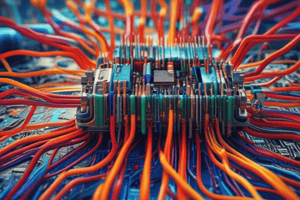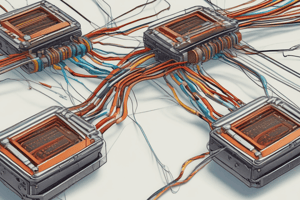Podcast
Questions and Answers
What is the equivalent resistance of the original circuit?
What is the equivalent resistance of the original circuit?
- 3R
- 2.5R (correct)
- 1.5R
- R
What is the voltage across the 7Ω resistor in the circuit?
What is the voltage across the 7Ω resistor in the circuit?
- 8.4 V (correct)
- 24 V
- 3.6 V
- 12 V
What is the definition of a junction in a circuit?
What is the definition of a junction in a circuit?
- A collection of branches that form a closed conducting path
- A point where two or more conductors meet (correct)
- A single element in a circuit
- A method of analyzing circuits
What is the current flowing through the circuit?
What is the current flowing through the circuit?
What is the voltage across the 3Ω resistor in the circuit?
What is the voltage across the 3Ω resistor in the circuit?
What is the method of analyzing circuits by breaking them down into smaller series and parallel sub-circuits?
What is the method of analyzing circuits by breaking them down into smaller series and parallel sub-circuits?
What is the definition of a loop in a circuit?
What is the definition of a loop in a circuit?
What is the voltage source in the circuit?
What is the voltage source in the circuit?
What is the definition of a branch in a circuit?
What is the definition of a branch in a circuit?
What is the purpose of Kirchhoff's Laws in circuit analysis?
What is the purpose of Kirchhoff's Laws in circuit analysis?
Flashcards are hidden until you start studying
Study Notes
Electric Circuits
- A series circuit is formed when resistors are connected end to end, with the same current flowing through each resistor.
- The equivalent resistance of a series circuit is the sum of the individual resistances: Req = R1 + R2 + R3.
- The equivalent resistance of a series circuit is greater than the greatest resistance of any individual resistor.
- Connecting two identical resistors in series produces an equivalent resistance that is twice the individual resistances.
Series and Parallel Circuits
- Resistors connected in series have the same current flowing through each resistor.
- Resistors connected in parallel have the same voltage across each resistor.
- In a parallel circuit, the electrons have multiple paths through which they can flow.
Kirchhoff's Laws
- Kirchhoff's Voltage Law (KVL) states that the sum of the voltage changes around a closed loop is zero.
- Kirchhoff's Current Law (KCL) states that the algebraic sum of the currents entering a junction is equal to the sum of the currents leaving that junction.
Circuit Analysis
- To analyze a circuit, break it down into smaller sub-circuits that are either series or parallel.
- Replace resistors in parallel with their equivalent resistance.
- Use Kirchhoff's laws and Ohm's law to determine branch voltages and currents.
Circuit Definitions
- A junction is a point in a circuit where two or more conductors meet, also known as a node or branch point.
- A branch represents a single element in a circuit, such as a resistor, current source, or voltage source.
- A loop is a collection of branches that form a closed conducting path.
Studying That Suits You
Use AI to generate personalized quizzes and flashcards to suit your learning preferences.




